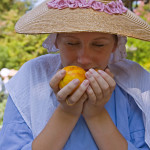 Gardeners are beginning to see the fruits of their labor with the ripening of fruits and vegetables in the Historic Area. Cucumbers are coming in by the basket full, potatoes are ready for digging, beets are nearly ready and the onions have just been harvested.
Gardeners are beginning to see the fruits of their labor with the ripening of fruits and vegetables in the Historic Area. Cucumbers are coming in by the basket full, potatoes are ready for digging, beets are nearly ready and the onions have just been harvested.
For the first time we are growing the Bull Nose Bell Pepper (Capsicum annuum) in addition to the cayenne peppers. Grown at Monticello by Thomas Jefferson, it has been described as one of the best pickled peppers because of their mildness and their thick, fleshy, and tender rind. The pepper matures from green to scarlet, getting sweeter over time. They are crunchy and good to eat raw or pickled.
Bull nose pepper
By the 18th century, peppers, particularly of the bell type, are often pickled. Richard Bradley, writing in Dictionarium botanicum (1728) observes: “These make a very good Shew in a Garden and are two ways useful, the green Pods make an excellent Pickle, and when the pods are full ripe, the Seed within them being clean’d and pounded in a Mortar is very good to put into Sauces, but ‘tis very hot, so that a little of it goes a great way; the long Pods are the best for pickling, and the ripe Seeds also of the long Pods are best for Sauces.”
Also ripening are the yellow egg plums (Prunus domesticus “Yellow Egg.”) This is a small European plum that,
in Wesley Greene’s opinion, is the best flavored plum of all.
Dead-heading the perennials is a full time task. As one flower fades another one steals the show. Bee balm (Monarda didyma) is the number one asked about plant in the garden by our guests and is a favorite with hummingbirds as well.
The tall, stately Rosinweed (Silphium trifoliatum) is an easy perennial that most gardeners do not know. It is currently blooming at the Colonial Nursery at about 8’ tall.


Leave a Reply